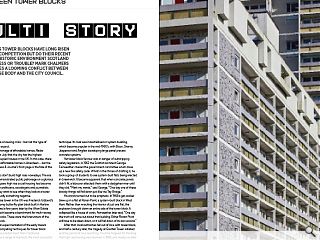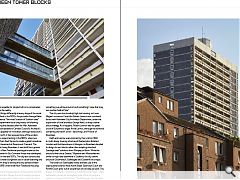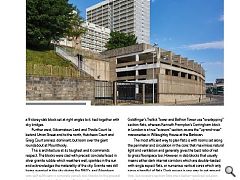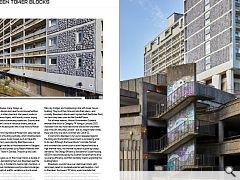Aberdeen Tower Blocks: Multi Story
20 Oct 2021
Aberdeen’s tower blocks have long risen above the competition but do their recent listing by Historic Environment Scotland spell success or trouble? Mark Chalmers investigates a looming conflict between the heritage body and the city council.
Today Aberdeen has a housing crisis – but not the type of housing crisis you’d expect. Rather than a shortage of affordable homes, Radio Scotland reported in July that the city has the highest proportion of unoccupied houses in the UK. In this case, there are at least 3000 unaffordable homes in Aberdeen … but the issue making the Press & Journal’s front page is the fate of the city’s tower blocks.
Scottish councils don’t build high rises nowadays. The era of tower building demonstrated public patronage on a glorious scale, but in recent years high rise social housing has become a Rorschach Test for politicians, sociologists and journalists. People see what they want to see when they look at a tower block, and that’s usually something negative.
The first high-rise tower in the UK was Frederick Gibberd’s The Lawn, a nine-storey butterfly-plan block built in Harlow in 1951. It was followed a few years later by the Alton Estate at Roehampton, which became a benchmark for multi-storey concrete housing blocks. These were the forerunners of the Age of the Tower Block.
The architectural experimentation of the early towers was lost once two competing techniques for tower block construction became predominant. Non-Traditional construction covered a range of methods, the most successful of which was the Wimpey “No Fines” in-situ concrete technique. Its rival was industrialised or system building, which became popular in the mid-1960’s, with Bison, Skarne, Jesperson and Anglian developing large panel precast concrete systems.
Yet tower block fervour was in danger of outstripping safety legislation. In 1962 the Scottish architect George Fairweather chaired the government committee which drew up a new fire safety code. Whilst in the throes of drafting it, he took a group of students to see system-built flats being erected in Greenwich. It became apparent that when concrete panels didn’t fit, a labourer attacked them with a sledgehammer until they did. “Mark my words,” said George, “One day one of these bloody things will fall down just like the Tay Bridge.”
His words turned out to be prophetic. In 1968 a gas cooker blew up in a flat at Ronan Point, a system-built block in West Ham. Rather than wrecking the interior of just one flat, the explosion brought down an entire side of the tower block. It collapsed like a house of cards. Fairweather later said, “One day the truth will come out about that building. Either Ronan Point will have to be taken down, or it will fall down of its own accord.”
After that, local authorities fell out of love with tower block, and half a century later, the tragedy at Grenfell Tower initiated another period of soul searching. You’d be forgiven for thinking that high rise housing was doomed in 1968, and doubly so after 2017. The rational conclusion is that tower blocks are a flawed typology – but our appetite for simple truths in a complicated world often denies the reality.
Aberdeen did things differently at every stage of the social housing journey. Back in the 1930’s, the journalist George Blake described Aberdeen as “the most Scottish of Scottish cities” and its Housing Department has a long history of following its own path. During the decades after the War, Aberdeen Corporation was comparable to Camden Council’s Architect’s Department in its appetite for innovation, although because it’s 500 miles too far north, it has received none of the acclaim.
The city began experimenting in the 1930’s, when Leo Durnin borrowed from Red Vienna to create a great horseshoe-shaped Modernist tenement at Rosemount Crescent. The twist here was that, being Aberdeen, it was built from granite. At the same time, a Non-Traditional prototype known as the Aberdeen Corporation In-Situ Concrete House was developed, and 120 were built in the late 1930’s. The city also constructed 40 timber-framed chalet bungalows clad in cedar boarding and shingles at Kincorth; they’re among the very earliest timber-framed houses in BRE’s mammoth Non-Traditional Housing study.
Aberdeen’s spirit of independence continued after the War. In April 1950, Baillie Frank Magee, the city’s housing convenor, declared that there were still appalling slums in the city which must be wiped out. “We are not going to build tenements, but something we will be proud of, and something I hope that may win another Saltire Prize”.
The city was slow to adopt high rise housing, so it was Magee’s successor Councillor Robert Lennox who combined forces with Aberdeen City Architects Department, under the supervision of chief architect George Keith, to map a tower block strategy. As it happens, Robert Lennox was the great uncle of Eurythmics singer Annie Lennox, although he achieved something she hasn’t so far – becoming Lord Provost of Aberdeen.
Keith and Lennox were inspired by their visits in 1959 to multi-storey housing schemes at Roehampton Estate in London and Hutchesontown in Glasgow, so Aberdeen decided to design its own blocks rather than adopting standard “package deal” solutions from Wimpey or Bison. While the blocks further out at Seaton, Tillydrone and Midstocket are similar to high rises elsewhere in Scotland, the city centre blocks at Gilcomstoun, Gallowgate and Castlehill are unique.
The towers on Gallowgate make dramatic use of the sloping land towards West North Street: Seamount Court and Porthill Court grow out of several tiers of concrete car park. The towers on Castlehill – Virginia Court and Marischal Court – were deliberately placed on the highest point of the city centre in order to command Union Street. The Gallowgate and Castlehill blocks share a common approach: an 18 storey slab block with a 9 storey slab block set at right angles to it, tied together with sky bridges.
Further west, Gilcomstoun Land and Thistle Court lie behind Union Street and to the north, Hutcheon Court and Greig Court are less dominant, but loom over the giant roundabout at Mounthooly.
This is architecture at its toughest and it commands respect. The blocks were clad with precast concrete faced in silver granite rubble which weathers well, sparkles in the sun and acknowledges the materiality of the city. Granite was still being quarried in the city during the 1960’s, and Aberdeen was self-sufficient in concrete panels too, thanks to the precast factory which John Fyfe ran at Rubislaw Quarry, and the Adamant works at Dancing Cairns.
Yet the true innovation in Aberdeen’s tower blocks isn’t visible from the outside. They employed one of the original ideas of Modern Movement, the scissors section, which made it possible to build dual aspect flats with efficient circulation. Le Corbusier gets the credit here, as they were developed from the dual aspect, interlocking flats he conceived for the Unité d’Habitation in Marseilles.
British architects travelled to France soon after the Unité was completed, and shortly afterwards the through-plan flat was adopted by London County Council Architects department. Most of the British examples are in London: Erno Goldfinger’s Trellick Tower and Balfron Tower use “overlapping” section flats, whereas Kenneth Frampton’s Corringham block in London is a true “scissors” section, as are the “up-and-over” maisonettes in Willoughby House at the Barbican.
The most efficient way to plan flats is with rooms set along the perimeter and circulation in the core: that maximises natural light and ventilation and generally gives the best ratio of net to gross floorspace too. However, in slab blocks that usually means either dark internal corridors which are double-loaded with single aspect flats, or numerous vertical cores which only serve a handful of flats. Deck access is one way to get around that, but scissors section flats are a better-resolved solution.
Put simply, a cross-plan or interlocking flat locates the kitchens, living and dining rooms along one aspect, connected to bedrooms on the opposite side by an internal flight of stairs. The internal stairs bridge over a circulation corridor, which typically runs along every alternate storey, and the adjacent flat is mirrored in two axes, so that two flats drawn in cross section begin to resemble a pair of scissors. In order to understand it properly, you need to draw it.
The long elevations at Gallowgate and Castlehill are powerfully articulated with concrete balcony beams and spandrel panels influenced by the Unité. Another Corbusian feature are the sky bridges: Erno Goldfinger was similarly inspired and just like Trellick Tower, the blocks in Aberdeen are tied together by walkways many storeys up.
Aberdeen’s slab blocks also have the communal facilities which high rise flats in other cities lack: the towers’ podiums have teak-lined entrance foyers, with laundry rooms, drying areas, and in some blocks community rooms too. Ground level is where George Keith’s circle of influence widens, because the towers are set on faceted piloti which owe more to Marcel Breuer than Corb.
The influences from International Modernism were married to the Scots tradition of building vertically, which stretches back to medieval tower houses. Z-plan towers such as Claypotts Castle in Broughty Ferry were cited by Basil Spence as a precedent for his high rise flats at Hutchestontown in Glasgow, and the influence was also picked up by Robert Matthew with his Queen’s College Tower in Dundee. These truly are Scots tower blocks.
Most authorities gave up on their tower blocks a decade or two ago and began demolishing them, but Aberdeen kept the faith: it was the last city in Scotland to build a high-rise block, in 1985. It also carried out maintenance and provided concierges, thus avoiding the blight of graffiti, vandalism and anti-social tenants which created ghettoes in the sky elsewhere.
Taken together, this group of eight tower blocks in Aberdeen is as good as anyone erected during the 1960’s. They’re unique in combining granite cladding, scissors section flats, sky bridges, and maintaining a link with tower-house building. They’re of their time and also their place – and crucially, Aberdeen’s blocks aren’t system built like Ronan Point, nor have they been overclad like Grenfell Tower.
For all these reasons, Historic Environment Scotland awarded the blocks a Category “A” listing in January 2021. Aberdeen now has more listed tower blocks than anywhere else in the UK, including London – but as Joseph Heller wrote, there was only one catch, and that was Catch-22.
In April 2021, Aberdeen City Council appealed against the listing and the Scottish Government is considering what to do next. Although the tower blocks’ concrete-framed and concrete-clad construction is both fireproof and has a high thermal mass, the thermal insulation is poor by today’s standards. The Energy Efficiency Standard for Social Housing (EESSH) was introduced by the Scottish Government to drive up energy efficiency, and that inevitably means upgrading the building fabric.
Elsewhere, councils have over-clad tower blocks with rainscreen panels or rendered external wall insulation – but in Aberdeen, the towers’ “A” listing would preclude that. Hence Catch-22, either architectural heritage or sustainability. Hopefully we’ll find a way to reconcile the two, rather than them becoming the poles of an argument which ends in de-listing, or worse.
|
|






